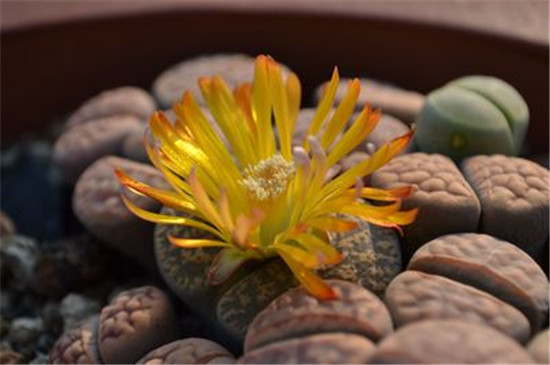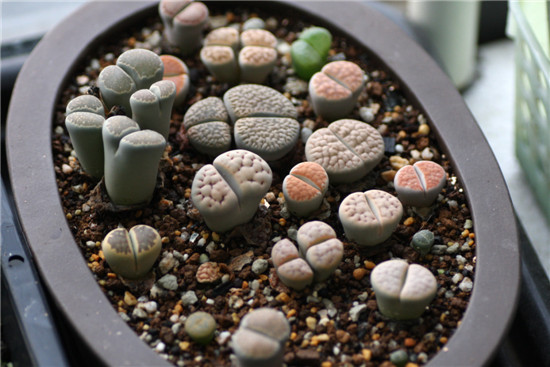What kind of plant is the stone flower?
Stone flower belongs to the family Amygdaceae, also known as stone flower, which is native to southern Africa. Next, let's take a look at what kind of plant it is.

Stone flower, also known as stone jade, butt flower, belongs to the family Amygdaceae, the general name of the species of stone flower, is referred to as "living stone". Because of its unique shape and colorful, it has become a very popular ornamental plant. Native to southern Africa, it grows and blossoms except for the rainy season. It is difficult to find stone flowers in gravel of origin, which is its self-protective nature in order to prevent predation by small animals, which is called "mimicry".
Stone flowers are native to southern and southwestern Africa and are often found in bedrock crevices and gravel. It is referred to as the "living stone". Grow and blossom in non-rainy season. It is difficult to find stone flowers in gravel of origin, which is called "mimicry". Because of its unique shape and colorful, it can be used as an ornamental plant.
Stone flower is a kind of succulent plant, which is mainly found in South Africa and Namibia. The plant is short, mainly composed of two opposite fleshy leaves. The top is flat, there are cracks in the center, and flowers will bloom in the cracks.

The culture method of stone flower
Like sunshine, the suitable temperature for growth is 20 ℃-24 ℃, and it should be cultured on the southward balcony or windowsill in spring and autumn, which is the peak period of its growth, and should be watered every 3-5 days to promote growth and flowering. The growth law of stone flower is that it begins to grow from March to April, pauses in the high temperature season, enters the summer dormancy period, continues to grow and blossom after cool autumn, and enters the overwintering period after the flower blossoms. Sex like sunshine, high temperature resistance, but need good ventilation, otherwise it is easy to rot. Avoid waterlogging. The winter temperature should be kept at 8-10 ℃.
Originally from the extremely dry and rainless desert gravel zone of Cape, South Africa, the annual rainfall is below 250mm, with an average temperature of 10 ℃ in winter and 20-25 ℃ in summer. Dormant in the dry season, the sphere gradually shrinks and buries into the soil, leaving only the top surface exposed to the surface like gravel. This kind of "mimicry" can prevent birds and animals from swallowing. In order to adapt to the environment, it evolved from dicotyledons to succulent typical bulbous plants, relying on water storage tissue in the cortex to preserve a rare bit of water. Its top face is called "window". There is chlorophyll in the window for photosynthesis. The top is slightly flat, with a gap in the middle from which 3-4-year-old plants produce yellow, white or pink flowers in autumn.

Humidity management
Stone flowers like a drier air environment, overcast and rainy days last too long, vulnerable to bacteria infection. For fear of rain, keep the leaves dry at night. The optimum air relative humidity is 40-60%.
Temperature management
The optimum growth temperature of stone flower is 15 ℃-25 ℃. For fear of high temperature and muggy heat, it goes into dormancy when the summer temperature is above 33 ℃. Avoid cold frost, the overwintering temperature needs to be kept above 10 ℃, and when the winter temperature drops below 7 ℃, it will also enter a dormant state. If the ambient temperature is close to 4 ℃, it will die of frostbite.
Fertilizer and water management
Stone flowers have strong drought tolerance and can grow under dry conditions, but this does not mean that they are not watered or fertilized; their roots are afraid of water stains, and if there is water in the flowerpot, or if they are watered and fertilized too frequently, it is easy to cause rotting roots. The principle of watering it is "dry and wet, dry and thoroughly dry, not dry, water thoroughly", and avoid wetting the plant during the day when watering.

Pest management
Stone flowers mainly occur leaf spot disease and leaf rot, which can be sprayed with 65% zinc wettable powder 600 times. Insect pests are harmful to ants and root-knot nematodes. Soil exchange method is used to reduce nematode damage. To prevent ants, you can use a set of pots for waterproof maintenance, so that ants can not climb to the tender and juicy spherical leaves.
The above is the whole content of what kind of plant the stone flower is for you. I hope this article can help you. Please continue to follow us.
Related
- Wuhan Hospital Iron Tree Blooming Result Was Instantly Frightened by the Gardener Master
- Which variety of camellia is the most fragrant and best? Which one do you like best?
- What is the small blue coat, the breeding methods and matters needing attention of the succulent plant
- Dormancy time and maintenance management of succulent plants during dormancy
- Minas succulent how to raise, Minas succulent plant pictures
- What are the varieties of winter succulent plants
- How to raise succulent plants in twelve rolls? let's take a look at some experience of breeding twelve rolls.
- Attention should be paid to water control for succulent plants during dormant period (winter and summer)
- Watering experience of twelve rolls of succulent plants
- Techniques for fertilizing succulent plants. An article will let you know how to fertilize succulent plants.



